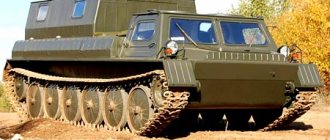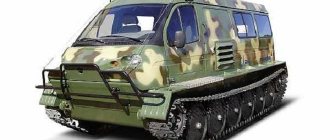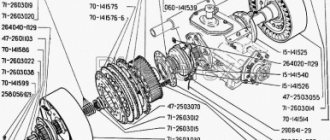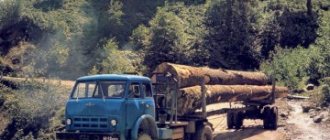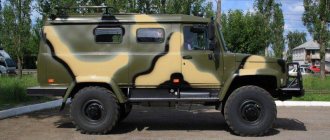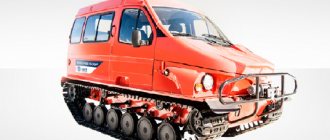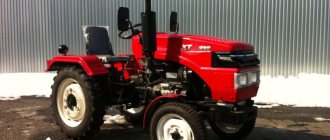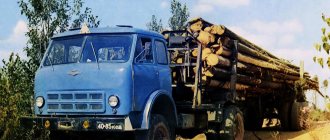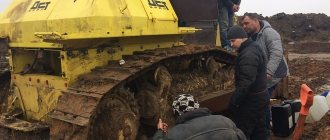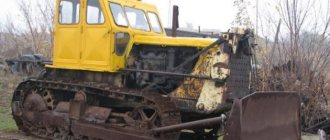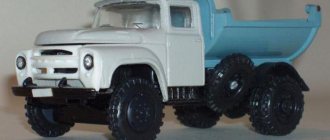The GAZ tracked snow and swamp-going vehicle is designed for transporting people and cargo over rough terrain, tundra, and snow cover. The main emphasis in the design of the machine is on reliability and functionality. Simple repairable components were used without unnecessary complications. The GAZ all-terrain vehicle is floating, and for floating vehicles the most appropriate arrangement is in a welded steel body made of thin sheets without a frame. Almost all armored personnel carriers are made according to this scheme. It was also chosen for GAZ-34039.
Main technical characteristics:
- Dimensions - 5720x2550x2130 mm;
- Curb weight – 4900 kg;
- Load capacity - 1200 kg;
- Cabin for 2 seats + lounge for 10 people;
- Engine - 110 hp;
- Fuel consumption - 50 l/100 km;
- Ground clearance 400 mm;
- Overcome descent/ascent - 35 degrees;
- Side roll angle - 25 degrees;
- Movement on water - 6 km/h;
- The weight of the towed trailer is 2000 kg.
Design Features
The main distinctive features of the Soviet all-terrain vehicle can be considered the following:
- Minimum number of structural elements;
- Low-speed tractor diesel of the Minsk Motor Plant MMZ D24512S;
- Upper hatches in the cabin, allowing you to get out if the all-terrain vehicle is flooded;
- Double-glazed glazing. All double-glazed windows, including two windshield windows, are made flat to reduce the cost of their replacement;
- The cabin and interior are insulated with lightweight polymer insulation;
- For mechanical protection of the cabin, a tubular frame is installed;
- The gearbox and main gear are combined in one housing;
- Drive to front sprockets, which resulted in a significant reduction in the number of transmission elements;
- Independent torsion bar suspension with a minimum number of parts.
The GAZ-34039 chassis is used for the production of all-terrain vehicles with a large number of modifications. There are about two dozen options for the body: 34039-22, -32, -33, -13, -12 and others. The cabin platform is made universal and can be easily converted to any task.
Modifications of GAZ-3409
34039
It is an “ideological” predecessor and does not have many common design solutions with the Beaver. It began to be produced back in Soviet times. It is not an amphibian, it has a caterpillar propulsion system, a slightly larger mass and a higher payload. It is still in production; there are versions of an ambulance all-terrain vehicle, a firefighting all-terrain vehicle, and a drilling rig. Designed for ten passenger seats.
34039 "Irbis"
A modern modification of 34039 with similar characteristics, but already having a number of modern features. The chassis is borrowed from 34039, but the upper part here is from an ekranoplan - a modern vessel that hovers above the water while moving. It is more ergonomic.
3351
Two-link caterpillar all-terrain vehicle GAZ 3351 “Los”. Thanks to the original design, it is able to easily overcome “difficult” climbs and areas littered with a large number of boulders and trees. It consists of two sections, front and rear, each of which has its own pair of tracks. The tracks give him the ability to move along the asphalt, just like the Beaver.
3344
An improved version of "Moose". Capable of carrying more cargo and more passengers. It is also a two-link amphibious tracked all-terrain vehicle.
Crawler propulsion system for impassable off-road conditions
In off-road conditions, tracked vehicles continue to be the most passable. It copes with roads in the tundra better than new models of all-terrain vehicles with low pressure tires. In addition, a low pressure tire is a very vulnerable mechanical component. If there is a puncture, the all-terrain vehicle breaks down, and it is impossible to carry a spare set of tires due to their weight and size. Caterpillars, on the contrary, are mechanically very strong. That is why they are used on military equipment. In this regard, classic tracked all-terrain vehicles will be in service for a long time and no replacement is expected. At the request of the customer, two types of tracks can be installed: ОШ and РМШ.
The predecessor GAZ-34039 GAZ-71 tracks did not have a rear sprocket. In this regard, the angle of attack when reversing was very large. Once in a depression (for example, in a river bed), the possibilities for reversing were greatly limited. Subsequently, the designers completely eliminated this defect.
Trekol and Yamal
Let's start with the simplest wheeled all-terrain vehicles, based on serial components of UAZ jeeps. So, “Trekol” is a regular “Hunter” on huge low-pressure wheels. The car drives great in mud and snow, but on hard-packed winter roads the interior is not very comfortable. The chassis is very shaking due to the terribly springy huge wheels - thanks to the tire inflation system through the hubs, you can relieve the pressure for greater comfort. But then the sidewalls of expensive tires will crack due to frost and load. Also, due to the size of the “shoes”, discs and axle shafts often burst, and the Hunter engine is rather weak for a heavy car. There is another all-terrain vehicle called “Yamal” - this is an improved “Patriot” on the same wheels. It exists in 4- and 6-wheel versions, has a more high-torque engine and an autonomous heating system. And in general, the design of the Yamal is more thoughtful and reliable, although such a jeep costs significantly more than the Trekol.
Engine and transmission
The heart of the all-terrain vehicle is the MMZ D245.12S diesel engine. One of the best engine models from the Minsk Motor Plant (MMZ) was selected. The main indicator of quality is efficiency and reliability. In terms of efficiency, the motor is at the level of the best world standards and consumes 218-250 g. diesel fuel per 1 kW of power. Total power - 110 hp. The working volume is 4750 cc. The compression ratio is 15. The weight of the engine equipped with auxiliary units in the crankcase together with the clutch is 500 kg.
The designers chose a low-speed tractor diesel engine. If for automobile diesel engines the operating speed with maximum torque is 3000-5000 rpm, then for D245-12S it is 2400 rpm. Reducing the rotation speed leads to increased reliability. The load on engine components is significantly reduced.
Transmission
Tracked all-terrain vehicles emphasize simplicity of design. Even on more expensive modifications, for example, GAZ-34039 Irbis, only a simple manual transmission is installed. The gearbox is located in the cabin and is covered with a noise-proof casing. Number of steps – 5 + reverse. A friction clutch is used to turn. The transmission compartment is located under the hood in the front part of the cabin.
The driver of the GAZ all-terrain vehicle controls three levers: turns left/right and the gearbox switch. Instruments indicating fuel level, oil level and temperature are made without electronics. They use only reliable mechanical parts. Maximum reduction in the number of electronic devices is a necessary condition for operating all-terrain vehicles in northern conditions. Access to the mechanical components of the all-terrain vehicle is through three hatches:
- hood in front of the cab (separation of the turning mechanisms and gearboxes for the tracks);
- hinged gearbox cover in the cab;
- the hood of the engine compartment between the cabin and the passenger compartment.
GAZ-34039
A Soviet veteran, graduated since 1985 and still serving as polar explorers. This is already a full-fledged tracked all-terrain vehicle, more reminiscent of an armored personnel carrier. This monster is powered by a 4-cylinder engine with 110 horsepower paired with a 5-speed manual gearbox. The engine is equipped with a preheating system, and the gearbox has a low gear. All this allows GAZ to feel great in snow, mud and in the conditions of the swampy spring tundra. An unpretentious diesel engine easily digests any diesel fuel, and an autonomous heating system warms up the large interior. By the way, it is designed for up to 10 people, in addition, 4 sleeping places can be equipped inside. Among the disadvantages, we can note the extreme slowness of this all-terrain vehicle and the considerable age of the surviving specimens.
Chassis
Consists of 12 track rollers. Each roller has its own independent torsion bar suspension unit. GAZ spare parts for the chassis offer two types of rollers. The differences can be seen in the photographs.
The support roller is a lightweight steel disk produced by stamping with welding on a wide rim, but another design is more popular. In it, two convex disks are welded into a three-dimensional structure. A rubber ring is placed on the rim. Rubberized rollers significantly extend the service life of the tracks. Typically it is 6,000 km, and with tracks with additional rubber shock absorbers - 12,000 km.
The short service life of the tracks is a factor limiting the operation of an all-terrain vehicle when transporting people and cargo over long distances. On paved and unpaved roads (passable for ordinary vehicles), it is recommended to transport it on a trailer. Loading is possible on a regular cargo trailer using a crane or by moving an all-terrain vehicle on an inclined plane (loading onto a tow truck). Weight and size characteristics do not impose restrictions on the transportation of an all-terrain vehicle on regular roads.
Prices for GAZ-3409 "Beaver"
The price of the Beaver snow and swamp all-terrain vehicle can vary greatly depending on the year of manufacture and the desire to sell. The new one sells for three and a half million. Used - from 300,000 to two or three million. However, if you can buy a GAZ 3409 “Beaver” all-terrain vehicle for a million, then it’s unlikely that anyone will buy it for two or three.
It should be noted that when purchasing a machine, the manufacturer provides a guarantee and certain service. Most consumers of this type of transport are located in Siberia, the Far North and the Far East. Having bought a used car, a person located in Moscow will be very puzzled by its transportation, and is also unlikely to be able to inspect it in person, and even all the available offers. At the same time, the new car can be delivered completely complete to the consumer, and its price will be comparable to a new business or luxury class car.
Interior heater Webasto
In northern conditions, interior heating is especially important. Using heat from a diesel engine to heat the cabin would reduce engine reliability, so it is not used. To heat the interior, a reliable autonomous interior heater from Webasto is installed. It is also a pre-heater for the engine. And here the designers found good optimization. Webasto produces heaters for cabins of trucks, vans, minibuses and buses. Installing a heater from a major manufacturer simplifies the search for spare parts. Fuel consumption - 100-250 g/h.
Comparison with predecessor GAZ-71
The uneconomical carburetor engine ZMZ-41 was replaced with a diesel engine D24512S. As a result, fuel consumption was halved (50 l/100 km instead of 100 l/100 km), and the fuel itself was replaced from gasoline to diesel. The total cost of operation has decreased by three times. The all-terrain vehicle has become fuel-unified with trucks, heaters, drilling rigs and other equipment widely used in the far north.
A rear sprocket has been added, the angle of attack of the track when moving in reverse has become the same as in the front.
The power reserve has been increased from 400 to 700 km. With a consumption of 50 l/100 km, the total tank capacity is 370 l.
Power plant of the all-terrain vehicle GAZ-3409
The all-terrain vehicle engine is diesel, Cummins ISF 2.8. The engine should soon be replaced with Huadong ISF 2.8, which is a complete analogue. Engine capacity is 2.8 liters.
Power is 130 horsepower. This is a fairly decent figure for off-road special vehicles. Such power is the key to a confident increase in speed, passing difficult sections from acceleration, and passing slippery soils. In combination with a tracked propulsion system, this allows you to maintain the stated elevation angle of 35 degrees even in deep snow or rain, which most similar all-terrain vehicles cannot boast of.
Good cross-country ability is also provided by the high engine torque of 285 Nm. This allows, with minimal loss of efficiency, to convert it directly into torque on the drive shafts of the machine. The rotation range is from 3800 to 1600 rpm. Such a fork allows you to fulfill not only automotive or all-terrain needs, but also to be used for tractors or other complex machines that require maintaining a certain speed.
A key characteristic for the modern consumer is the fuel consumption of an all-terrain vehicle. It is 30 liters per 100 km on the highway. The figure, I must say, is very high. Its closest competitor from Japan from the Isuzu company, Ohara, is approximately one and a half to two times smaller with the same characteristics.
However, for the average Russian consumer of all-terrain vehicles, oddly enough, this is not a big problem, despite the inflated prices for fuel in Russia. By the way, the tank capacity is 185 liters, which is enough to cover a very significant distance, even off-road.
